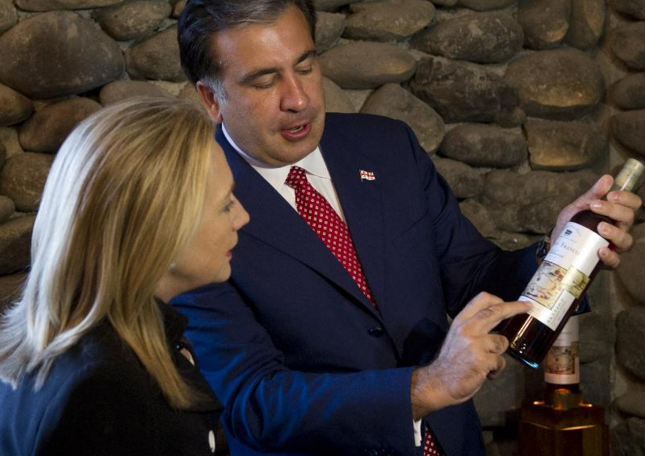作者: 發布時間:2016-11-07 關注度:127

The leading U.S. business magazine Forbes published a small article focusing on Georgian wine.
美國權威的商業雜志《福布斯》發表了一篇聚焦格魯吉亞葡萄酒的短文。
The piece "'Ancient' Winemakers Georgia And Lebanon Grow Exports Into China's Thirsty Market" is by Jeannie Cho Lee MW, who is the first Asian Master of Wine.
這篇題為《中國葡萄酒市場如饑似渴,“古老釀酒世界”格魯吉亞和黎巴嫩出口攀升》是由亞洲第一位葡萄酒大師李志延(Jeannie Cho Lee)撰寫。
The article is illustrated by photo of ex-president Mikheil Saakashvili with current U.S. presidential candidate Hillary Clinton.
文中配有格魯吉亞前總統米哈伊爾·薩卡什維利(Mikheil Saakashvili)與當前美國總統候選人希拉里·克林頓(Hillary Clinton)的合影。
Almost the whole of the article is devoted to Georgian wines:
"When Hugh Johnson, the inimitable British wine writer, coined the terms “old world” and “new world” to refer to wines from traditional European regions versus former European colonies, he left out the birthplace of wine: the ancient world. How else should we classify wine producing countries like Georgia, Lebanon, Armenia and Israel that are a few thousand years older than the “old world”?
文章通篇關注格魯吉亞葡萄酒:
“英國葡萄酒作家休·約翰遜(Hugh Johnson)獨辟蹊徑地創造了“舊世界”和“新世界”兩個詞匯,借以區分傳統歐洲產區與前歐洲殖民地之間的不同。只可惜他忽略了葡萄酒的發源地——古老的釀酒世界。那么我們又該如何定義格魯吉亞、黎巴嫩、亞美尼亞和以色列等比“舊世界”還要悠久千年的釀酒國家呢?
Georgia boasts itself as the “cradle of wine civilization” with winemaking culture going back over 6,000 years, several thousand years before the first vines were cultivated in Bordeaux, Tuscany or Rioja. The wines from Georgia were favorites of the former Soviet Union’s power elite because of the quality and history of the wines, especially from the region of Kakheti. But a ban on Georgian wines by Russia from 2006 until 2013 meant the industry was forced to look for alternative export markets.
格魯吉亞自詡為“葡萄酒文明的發源地”,擁有6000年以上的釀酒文化,比最先栽培葡萄藤的波爾多、托斯卡納或里奧哈還要早上幾千年。格魯吉亞(尤其是卡赫基產區)葡萄酒因其上乘的品質和深厚的歷史底蘊,而深受前蘇聯權力精英的喜愛。只不過,俄羅斯于2006至2013年的一紙禁令,格魯吉亞葡萄酒不得不另尋他途,開辟新的出口市場。
As a result, Georgian wines have made substantial inroads into China – the Georgian agriculture minister said a free trade agreement to be signed in December this year will be hugely beneficial for both the Chinese and Georgian wine industries. According to China Daily, Levan Davitashvili, Georgia’s Minister of Agriculture, said 5 million bottles of Georgian wine were exported to China in 2015. They are likely expecting that number to double in a few years after the free trade agreement comes into effect.
日前,格魯吉亞葡萄酒在中國市場取得了實質性的進展。格魯吉亞農業部長表示,今年12月簽署的自由貿易協定對于中國和格魯吉亞葡萄酒產業均是重大利好。據《中國日報》報道,格魯吉亞農業部長Levan Davitashvili介紹,2015年,格魯吉亞葡萄酒中國出口量達500萬瓶。據其估計,自由貿易協定生效后幾年內,該數字將會翻番。
While Kakheti, Racha-Lechkhumi and Kverno Svaneti are difficult Georgian regional names to remember, the full bodied, gutsy red wines from the Saperavi variety blends are finding a market in China. I recently tasted over twenty Georgian wines and was very impressed with the red wines. Some were modern and juicy with a touch of savory herbs in wines like Teliani Valley’s 2013 Cabernet Sauvignon and Saperavi blend. While others were more earthy and tannic, made in the traditional style."
雖然消費者記不住拗口的格魯吉亞地名“卡赫基”、“拉恰-列且呼米”和“Kverno Svaneti”,但是酒體飽滿、果味濃郁的薩別拉維混釀紅葡萄酒卻在中國市場贏得了一席之地。我最近品嘗了二十余款格魯吉亞葡萄酒,對它的紅葡萄酒印象非常深刻。有些葡萄酒契合時尚潮流,滋味醇厚并帶著淡淡的草本芬芳,比如蒂里阿尼山谷2013年赤霞珠和薩別拉維混釀葡萄酒。另外,傳統工藝釀造的葡萄酒透著泥土氣息、單寧突出,更顯樸實無華與獨特韻味。
In the last paragraph the author briefly mentions the wines from Lebanon: "Another ancient wine region that has captured the hearts of wine lovers since the 1980s is Chateau Musar from Lebanon".
文章結尾,作者還提及黎巴嫩葡萄酒,稱其為:“自上世紀八十年代以來,另一個古老產區擄獲了葡萄酒愛好者的心,它就是來自黎巴嫩的穆薩酒莊 (Chateau Musar)。”








